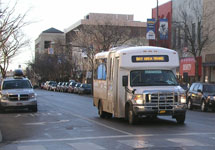MLUI / News & Views / Articles from 1995 to 2012 / BATA Making Big Changes
BATA Making Big Changes
Faster, Direct Lines Target Commuters
January 10, 2012 | By Glenn Puit
Great Lakes Bulletin News Service
 | |
| Glenn Puit/MLUI | |
| Chrissy Sterling |
TRAVERSE CITY—James Holton and Chrissy Sterling rarely, if ever, ride the bus.
Like others, they see public transit as a valuable and important service, but the area bus system just isn’t timely enough, compared to driving their cars.
“It’s not convenient,” said Mr. Holton.
Officials at the Bay Area Transit Authority, which serves Grand Traverse and Leelanau Counties, know that many people who could use the bus feel the same way: They almost always drive because riding BATA buses takes more time.
But now BATA is launching a huge makeover, backing away from its traditional, often slow, door-to-door dial-a-ride service in favor of many more direct, “fixed” routes that operate on tightly defined schedules. BATA officials say the changes will make bus riding much more attractive to many people.
That’s because the new, fixed routes allows patrons to know exactly how long their ride will take—something dial-a-ride cannot do.
BATA Executive Director Tom Menzel said the new approach would provide more of the steadiness and predictability that commuters need to get to and from work or school conveniently—and on time.
“Our riders will have more stops and more options in terms of a system that gets people to where they want to go in a realistic amount of time,” Mr. Menzel said.
Under the current dial-a-ride system, riders must call a day ahead of time to reserve a spot on the bus, and the bus then picks the rider up at their front door.
But here’s the catch: That process repeats for each individual rider. So dial-a-ride patrons must ride along to other, multiple, home pick-ups before arriving at their own destination. They end up spending a lot of time on the bus.
Mr. Menzel said using direct routes would change this. Buses will take the same, direct route every time. Instead of being picked up at their doorsteps, riders will board at bus stops along the new, direct routes.
“We are trying to move to a fixed route system where you know the schedule, and you know exactly when you are going to get to town,” said Kurt Braun, the transportation services manager at BATA.
 |
But because dial-a-ride helps the region’s disabled population by picking them up at home, Mr. Menzel said BATA is not eliminating that service. Instead, dial-a-ride will soon only serve those who truly need it. All others will need to get to a bus stop along a direct, fixed route.
“So, if you still need a wheelchair vehicle, you still have access to that,” Mr. Menzel said.
Jim Moore, executive director of the Northern Michigan Disability Network, said the key is to find the right balance as BATA moves to more direct, schedules routes. He noted that many people with disabilities depend on dial-a-ride to maintain their quality of life.
“There are individuals who can’t access the fixed route system and are only able to get to one of the bus lines where there is a dial a ride system,” Mr. Moore said. “We feel very strongly that we hope there are no cutbacks in dial a ride (for those riders.) We also know if more people are using the fixed route, that will mean less pressure on the dial a ride system.”
Working in Chicago
BATA’s big change mirrors changes other public transit agencies are considering as they deal with similar issues of need, available resources, and costs. And some of those other systems are finding success with the new approach.
In suburban Chicago, for example, the PACE Suburban Bus system started working this year to see if adding certain direct bus routes could actually help, not inconvenience, some riders with disabilities.
 |
“One of the biggest issues for us as an agency was related to funding,” said PACE spokesman Patrick Wilmot. “It’s much more expensive for us to provide dial-a-ride and paratransit service on a per-passenger basis because of the specialized nature, but a fixed route is much less expensive. Given some funding shortfalls in our paratransit budget, and because of the decline of the economy in recent years, we needed to look for some ways to reduce our expenses.
“A good way to do that was to promote the use of the fixed route system for people with disabilities who might be able to use it,” he said. “Some may not be able to use the fixed route, and it’s not for everyone, but if we can get a small number of people to use them for fixed route trips, it would have an impact on the bottom line; it increases the customer’s mobility because they don’t have to worry about booking their travel the day before.”
Mr. Wilmot and others at PACE said they are already seeing the benefits. Many riders have had greater travel flexibility rather than being tied down to a reservation they had to make a day before, and the bus system has also become more efficient.
The move seems to be paying off.
“Shifting just 1 percent of our paratransit trips to fixed route will result in a savings of $1 million, with no loss of mobility or independence for passengers,” said Richard A. Kwasneski, chairman of the board for PACE, in a recent column describing the changes. "We want to give riders more travel options in a way that will save money for both the passenger and the system.”
Back in Traverse City, when asked about the similar changes BATA is making, Ms. Sterling said that timely routes are exactly what she is looking for.
“I think it would be great for Traverse City—we need it,” she said.
Glenn Puit is a policy specialist for the Michigan Land Use Institute. Reach him at glenn@mlui.org.





